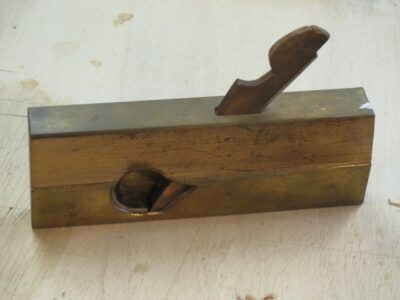Infill Planes
A few weekends ago I attended the PATINA monthly gathering, as always getting my tool-flea-market fix (I bought only a few small items) before going inside for the presentation on infill planes by Lee Richmond of The Best Things tools, towards whom I have sent very many dollars over the years.
The talk and Q&A were excellent and very informative and I learned a lot, particularly the history of infill plane kits that were available to craftsmen, and the prevalence of planemakers making tools to be marketed under other branding than their own. More about both points in a minute.
It got me wondering about my own inventory of infill planes which, when compiled, was more numerous than I initially thought. I don’t know why as these are tools I use regularly. I guess I just never thought of them in that way.
Here is my own collection, presented in no particular order.

The prize of my collection is my Robert Towell miter/shooting plane, probably from the second quarter of the 19th century. Towell was one of the makers who produced tools bearing his own imprint and sold from his own shop, along with unmarked planes sold by other purveyors. Mine is one of the latter, devoid of any maker’s marks but with all the hallmarks of his work. His planes were apparently of this form and are highly desirable by collectors, provided they bear his mark.


This image from the interwebz shows the maker’s mark that is missing on my plane. That lacunae is what made this plane affordable, otherwise the $5k price tag would have been beyond the realm of consideration for me. And, Mrs. Barn would have probably killed me…
Since mine is unmarked, it was “affordable” to me (still pricey by my standards but only 10% of the price had it borne his stamp) and I bought it from a flea market session at Martin Donnelly’s about 20 years ago. The throat is so tight (about 1/3 mm) I find the only useful purpose it has for me is trimming the end grain of boards on a shooting jig.

Contemporary tool maker Raney Nelson of Daed Tools made a series of Towell-inspired planes maybe 20 years ago and I got it through trading some other materials and tools for it, otherwise I could have never afforded it.

Like Towell and Raney’s friend Konrad Sauer the construction is hammered dovetails, with I think African Blackwood as the infill. I really should ask him more about this tool the next time our paths cross, as they do occasionally.

It’s just a bit too small to use as a block plane, but perfect for small shooting tasks. This plane might have evolved into the “collectible” realm as I am not sure how much plane making Raney does any more since he and Chris Schwarz started Crucible Tools.


This still-under-restoration smoother is one of those Richmond said was probably a kit of sorts, with the metal shell being sold as a chassis for a woodworker to make the wooden infill components. I got this late 19th century tool in a box lot of other derelict tools at a flea market, devoid of iron or wedge, looking like at had a stint inside a concrete mixer. I cobbled it together as a functioning plane after restoring the totally trashed wooden infills, ebonizing them and leaning the steel shell.

I was never really happy with the wedge or the iron I dug out of my spare parts drawer, so I asked my friend Josh Clark to look through his inventory to see what he had. I soon received a really nice double iron in the mail that fits the sole mouth very tightly and have been puttering on making a wedge off and on ever since. If I have success with a wooden wedge I just might make another out of ivory. Just because I can.

For many years Ron Hock used to sell kits to make planes, and this started as one of those. The maker in this instance was my friend Joe who gave it to me 15(?) years ago for reasons I can no longer recall. It was a very nice plane but underweight for what I wanted.


During the first Roubo manuscript I modified it with heavy brass cheeks and a bit of stylizing to use it as a veneer/parquetry shooting plane.

Some years ago at a Lie-Nielson event I bought this infill plane from Mateo Panzica of Lazarus Planes in Louisville KY. His fabrication approach is almost 180 degrees opposite from Towell and Nelson but you cannot argue with the results.


This weighty smoother is simply superb and gets regular use at my bench, perhaps more than any plane (other than my sleigh-style block plane that is going into the grave with me, unless of course it goes to L’il T or his brother). If I needed more new planes I would probably divide my money between Lazarus and Steve Voigt, although the Lasso of Truth would reveal I do not really need any more. (Other than a toother from Steve Voigt, if he ever gets them to market).

An infill I made all by my lonesome is this plane designed specifically for, and not useful otherwise to tell you the truth, shooting the edges of sawn parquetry elements. I saw Paterick Edwards demonstrate a vintage version of this plane at Williamsburg several years ago and decided I had to have one myownself.


I started out with a derelict one-inch rabbet plane body and beveled one side, then silver soldered the brass shell. I am really pleased with its performance.



That is a nice set of planes, Don. I don’t think Raney is involved with Crucible Tools any longer.
Take care.
Bob Leistner